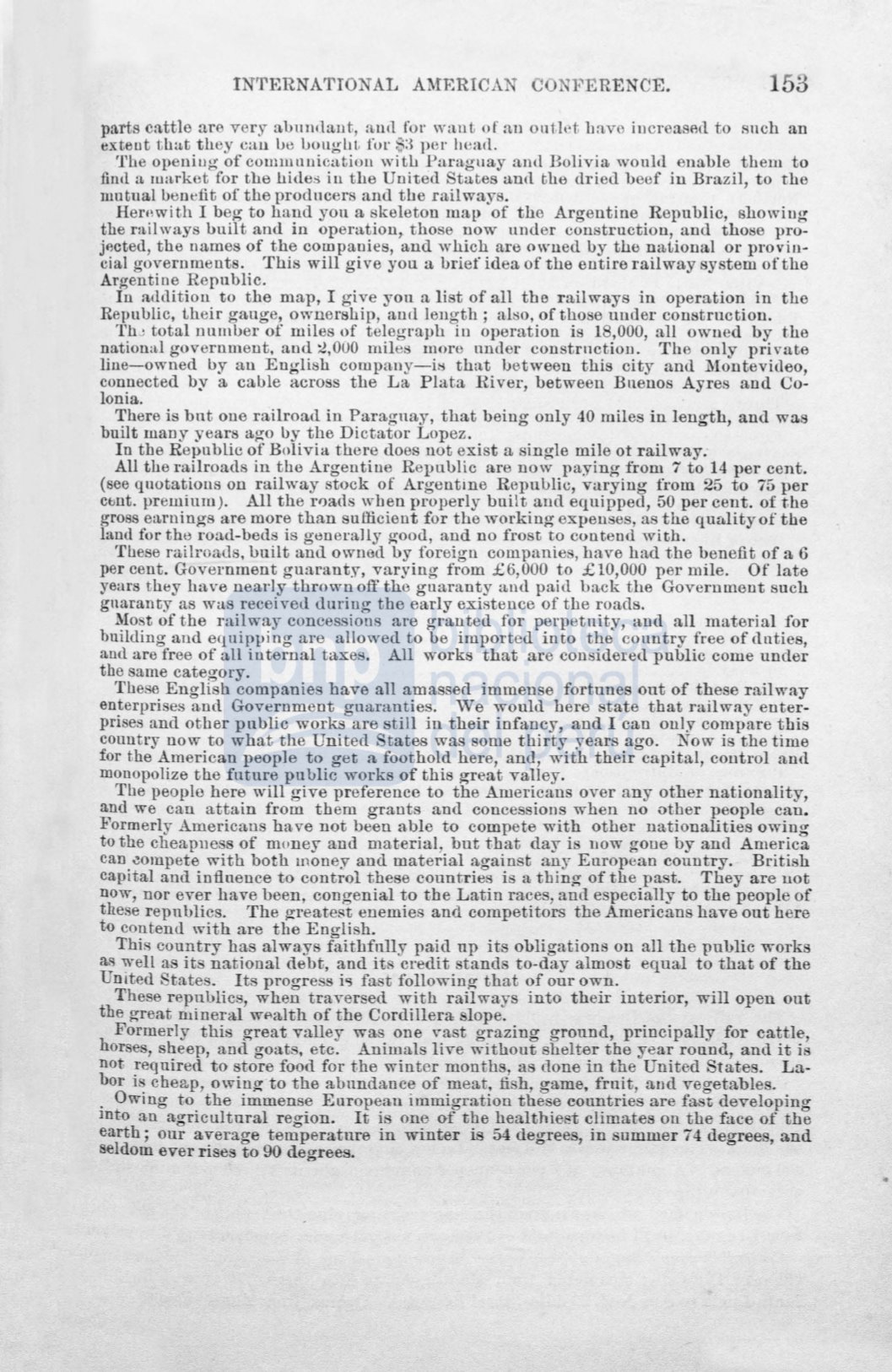

INTERNATIONAL AMERICA
CO
l<~ERENCE.
3
parts cn.ttle are very abunt1ant, :tllf1 for want of :tn ontlt>t h:we increaser1 to snch an
extent thut they cau be uougllt. for
:;>:~
per heaü.
Tbe openiug of comJunuie.ttiou with Paraguay and Bolivia woulcl enable them to
finü a ma.rket for the hieles iu the United States an<l tlte dríeu beef in Brazil, to tlte
mutual benefit of the producers and the raílways.
Hernwith I beg to hand you a skeleton map of the Argentine Republic, showiug
the ntilways buílt and in opera.tion, those now under construction, and those pro–
jected, the names of the companies, and which are owued by the na.tional or provin–
cial governments. This will give you a brief idea of the entire railway system ofthe
Argentine Republic.
In addition to the map, I give you a list of all the railways in operation in tlte
Republic, their gauge, ownership, and length; ali:;o, ofthose unuer construction.
Th.J total numuer of miles of telegraph in operation is
18,000,
all owued by the
natiomd government, and
~.000
miles more nnder constrnctiou. The only prívate
line-owned by an English
company-i~;
tha.t between this city and Montevideo,
connected by a cable across the La Plata River, between Buenos Ayres and Co–
lonia.
There is but one railroad in Paraguay, that being only
40
miles in length, and was
built ruany years a?:o by the Díctator Lopez.
In tbe Republic of Bolivia there does not exista single mile ot railway.
AU tlte railroads in the Argentiue Republic are now paying from 7 to 14 per cent.
(see qnotations on railway stock of Argentine Repnl>lic, varying from 25 to 75
perctJnt. premium). All the r0ads wben properly built ancl equipped,
50
per cent. of
t.hegross earuings are more than sufficient for tbe working expenses, as the qua.lityof
theland for the road-beds is generally good, and no frost to conteud wi
th.Tllese raih·oads, built and ownad by foreigu companie , bave had
t.hebenefit of a 6
per cent. Government guaranty, varying from
.f:6,000
to
.f:lO,OOO
per mile. Of late
years they have nearly throwu off tbe guaranty and paid
bn.cktlte Government suclt
gna.ranty as was receivetl uuriug tbe early existence of t
he roacls.
Most of the raílway conces ions are granted for perpetnity, a.ncl all material for
building and equipping are allowed to be imported into tbe couutry free of duties,
and are free of all internal taxes. All works that are considered public come under
the same category.
These Engliah companies have a1l amassed immense fortunes out of these railway
enterprises ancl Government guaranties. We would here
tate tbat railway enter–
prises and other public works are still in their infancy, and I can only compare tbis
conutry now to wbat the United
tates wa,<; sorne thirty years ago. Now is tbe time
for the American people to get a foothold here, and, with their capital, control anrl
mouopolize the future puulic worka of this great valley.
Tlle peoplc here will give preference to the Americans over any other nationality,
and we can attain from tbem grauta and conce sions when no vther people can.
Formerly Americana have not been able to compete with otber nationalities owing
to the cheapneas of money and material, bnt tbat day is 11ow gone by and America
can 0ompete with both money and material against any European country. Britiab
capital and infiuence to control these countries is a tbing of tbe past. They are uot
now, nor ever have been, congenial to tbe Latín races, ancl especially to the people of
these repuulics. The greatest enemies and competitors the Americana have out bere
to coutenu with are the Engli h.
This country has alway faitltfnlly paid np its obligations on all the public work
as well as it national debt, and it credit tand
to-day almost equal to that of the
United States.
Its progre s i'l fast following that of our own.
The e republics, when traversed with railways into their interior, -will open out
tbe great lllineral
W~'alth
of tbe Cordillera lope.
Formerly this great valley wa one vast grazing ground, principally for cattle,
hor es, sheep, and goat , etc. A.nimals live witltout shelter the year ronnd, and it is
not required to store food for the winter montlts, a done in the United State . La–
bor i cheap, owing to the abnndance of meat,
fi
h, game, fruit, and vegetable .
. Owing to the immense European immigration the e countries are fa
t
developing
mto an agricultural region.
It is one of tbe healthie t climates on tlte face of tbe
earth; our average temperatura in winter is 54 degree , in ummer 74 degree , and
seldom ever rises to
90
degrees.
















